International Journal of Scientific & Engineering Research Volume 4, Issue3, March-2013 1
ISSN 2229-5518
Stability analysis on plain journal bearing with effect of surface roughness
S.Udaya Bhaskar, Mohammed Manzoor Hussain, Md. Yousuf Ali
Abstract— The effect of surface roughness has a major role in steady state and dynamic characteristics of hydrodynamic journal bearings. To evaluate the surface roughness effect on bearing surface, it is necessary to concentrate upon the surface roughness profiles. Flow factor method is used in the analysis to evaluate the roughness terms and the finite difference method is used to find the pressure distribution over the bearing surface. The steady state characteristics are with transverse, isotropic and longitudinal surface pattern are compered with the bearing having smooth surface profile. The results showed a considerable effect on steady state and dynamic characteristics of the journal bearing system.
Index Terms— attitude agle, eccentric ratio, journal bearing, reynolds equation, sommerfeld number, surface roughness.
—————————— ——————————
1 INTRODUCTION
Fluid film bearings are machine elements which produce smooth (low friction) motion between solid surfaces in relative motion and to generate a load support for mechanical compo- nents. The lubricant between the surfaces may be a liquid or gas. Fluid film bearings are designed to support static and dynamic loads, and consequently as their effects on the per- formance of rotating machinery are of great importance.
In the design of high speed rotary machinery, consideration of surface roughness is important to predict the steady state characteristics and stability analysis of the hydrodynamic journal bearing. It is observed by B.C Majumdar [5] that an increase in the load carrying capacity occurs when the effect of surface roughness is taken into consideration. Zhand and Qiu investigated the effect of two sided purely longitudinal, trans- verse and isotropic surface roughness on hydrodynamic lubri- cation of dynamically loaded journal bearing. Surface appre- ciably effects the lubrication of surfaces if the film thickness is same order as the roughness. By using the Christensen's sto- chastic model, the steady state curves were obtained.
2 Effect of surface roughness
The importance of roughness in predicting bearing perfor- mance has gained considerable attention in tribology. All pre- vious developments were based on perfectly smooth bearing surfaces. In reality however engineering surfaces are covered with asperities. Even for a ground surface , asperities might reach 1.25 m in height and ten times this value in lateral spac- ing; the lateral distance we equate with the in plane character- istic length Lxz .The minimum film thickness in a journal bear-
ing ,say of diameter D=25mm operating eccentricity =0.5 is
h min =12.5 this minimum thickness is selected here to repre- sent the across the film characteristic length Ly . Because the average asperity height is one order of magnitude smaller than the minimum film thickness, we might be tempted to ignore surface roughness. However the local characteristic
Reynolds roughness. When there is significant pressure varia- tion across the film due to surface roughness, to the extent that the lubrication approximation is no, longer valid.
Tzeng and Saibel were among the first to apply statistical methods to lubrication of rough surfaces. They investigated the inclined plane slider having one dimensional roughness transverse to the direction of relative motion. This method employed by the investigators is based on the statistical aver- aging of Reynolds equation. As remarked by Tripp, the Reyn- olds equation has the property, unusual among the equations of mathematical physics that the boundary conditions are in- corporated into the equation – it is this feature of Reynolds equation that offers for ensemble averaging the equation itself.
Christen and Tonder make two fundamental assumptions in their analysis:
1. The magnitudes of pressure ripples due to surface roughness are small and the variance of the pressure gradient in the roughness direction is negligible.
2. The flow in the direction transverse to roughness direc- tion has negligible variance.
Governing equations
The basic equation that gives pressure distribution in bear-
ings is Reynolds equation. Steps involved in obtaining solu-
tion are discussed.
Surface roughness
Consider two real surfaces with normal film gap h in the sliding motion. Local film thickness of ht for this friction to be of the form
lengths are of the same magnitude,
Ly = Lxz =1.25 m

violat-
ing the thin film assumption of lubrication analysis, and it
becomes questionable whether the Reynolds equation is at all
valid. In case when the lubrication approximation still holds
Fig: 1. Two rough surfaces in relative motion
even though the surfaces are rough, we said to be dealing with
hT h 1 2
(1)
IJSER © 2013 http://www.ijser.org
International Journal of Scientific & Engineering Research Volume 4, Issue3, March-2013 2
ISSN 2229-5518
The combined roughness 1 2
2 2 2
with variance
p
xx
pi1, j 2 pi, j pi1, j

2
1
2
(2)
The equation for the average pressure
2
D
p pi, j 1 2 pi, j pi, j1


yy
L
p h3
pm

p hT
3 p

y
xx

x

12 x
yy
y
12 y
p p
(3)
3
i1, j i1, j sin sin i

U U h
U U
S h

2


hi hi3
1 2 T 1 2 xx T
(5)
2 x

2 x t
To study surfaces with directional properties the surface characteristic γ can be used. The parameter γ can be viewed as the length to width ratio of a representative asperity. There are mainly three sets of asperity patterns are identified purely
1. | Transverse roughness pattern | γ<1 |
2. | Isotropic roughness pattern | γ=1 |
3. Longitudinal roughness pattern γ>1
Reynolds equation
A number of restrictive assumptions are introduced before starting with the present analysis of journal bearings. The as- sumptions are:
1. Inertia and body forces of the lubricant are neglected ;
2. Both bearing and the rotor are rigid;
Fig.2: Finite difference scheme - Mesh
On simplifications the above equation becomes
P(i, j )
xx P P (i 1, j ) P (i 1, j )
2 2
3. The flow is laminar;
4. The no-slip condition exists at the fluid/solid interface;
D

L

yy P P (i, j 1) P (i, j 1)
5. Pressure variation across the film thickness is negligi-
3 sin 2
ble;


P (i 1, j ) P (i 1, j ) sin 3
6. The density of the lubricant is constant;
2 h h (6)
7. The operation of the bearing system is isothermal.
2 2
D
To investigate the effects of surface roughness on the steady

2 xx P yy P

state and dynamic characteristics of journal bearings, the modi-
L y
fied Reynolds equation for hydrodynamic lubrication can be
written as follows.
For steady loading and incompressible lubricants the gen- eralized Reynolds equation becomes
It is seen that the pressure at any mesh point i, j is ex-
hn2
p p
hn2
p p
6vU n
h
s
pressed in terms of pressure at four adjacent points. To start
the iteration process the pressure at all the mesh points are

xx
x x y

yy
y
xx

x
(4)
assumed and those at the boundaries are set.

A developed view for half of the bearing is drawn in. the area is divided into a number of mesh sizes y and using
Load carrying capacity of journal bearing:
The tangential and radial components of the load is written as

central difference quotients, the equation can be written in the form as
2

w y c
2
wz c
w ; wz (7)


y 6 UR 2
6 UR 2
Total load carrying capacity is calculated as follows:

wh
2 2
wy wz

w c 2

; wh h 2
6UR
(8)
IJSER © 2013 http://www.ijser.org
International Journal of Scientific & Engineering Research Volume 4, Issue3, March-2013 3
ISSN 2229-5518
Attitude angle is calculated as
1 wz

tan
w y
Sommerfeld number

(9)
2
N S DL R


S
(10)
wh C
3 Results and Discussion
The steady state analysis of plain journal bearings has been carried out at various eccentric ratios with surface roughness for different L/D ratios. Attitude angle and sommerfeld number have been determined and finally compared with results in ref-
erence [2]. The results obtained have plotted for comparision for
Fig.5: Variation of Attitude angle ( )
with Eccentricity ra-
different surface roughness parameters.
tio ( ) for isotropic surface roughness at L/D = 0.5
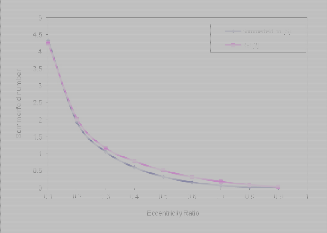
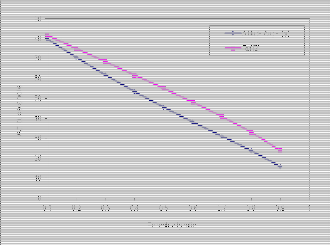
Fig.6: Variation of Sommerfeld no (S)
with Eccentricity ra-
Fig.3: Variation of Attitude angle ( ) with Eccentricity ra- tio ( ) for transverse surface roughness at L/D = 0.5
tio ( ) for isotropic surface roughness at L/D = 0.5
Fig.4: Variation of Sommerfeld no (S)
with Eccentricity ra-

Fig.7: Variation of Attitude angle ( )
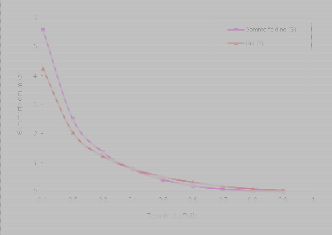
with Eccentricity ra-
tio ( ) for transverse surface roughness at L/D = 0.5
tio ( ) for longitudinal surface roughness at L/D = 0.5
IJSER © 2013 http://www.ijser.org
International Journal of Scientific & Engineering Research Volume 4, Issue3, March-2013 4
ISSN 2229-5518
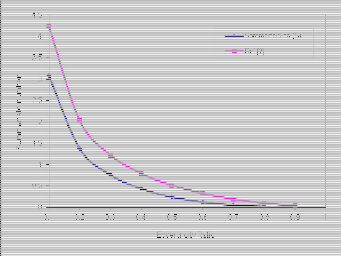
Fig.8: Variation of Sommerfeld no (S)
with Eccentricity ra-

Fig.10: comparision of Attitude angle with Eccentricity ra- tio for isotropic surface roughness at all L/D ratio’s
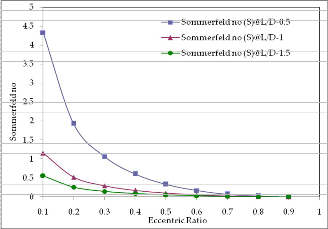
tio ( ) for longitudinal surface roughness at L/D = 0.5
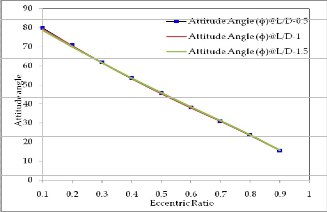
Fig.9: comparision of Attitude angle with Eccentricity ratio
for transverse surface roughness at all L/D ratio’s
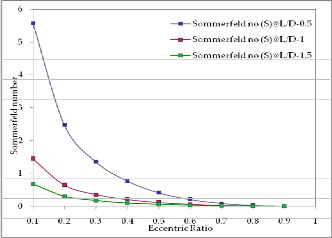
Fig.9: comparision of Sommerfeld no S with Eccentricity ra- tio for transverse surface roughness at all L/D ratio’s
Fig.11: comparision of Sommerfeld no S with Eccentricity ra- tio for isotropic surface roughness at all L/D ratio’s

Fig.12: comparision of Attitude angle with Eccentricity ra- tio for longitudinal surface roughness at all L/D ratio’s
IJSER © 2013 http://www.ijser.org
International Journal of Scientific & Engineering Research Volume 4, Issue3, March-2013 5
ISSN 2229-5518

Fig.13: comparision of Sommerfeld no S with Eccentricity ra- tio for longitudinal surface roughness at all L/D ratio’s
Analysis of plain journal bearing:
The work has been further extended in modeling the plain
journal bearing using GAMBIT software. The meshed model is
analysed using ANSYS-fluent. The isotropic roughness for the
palin bearing is applied and analyzed for different eccentric
ratios to obtain the pressure distribution contours of plain jour-
nal bearing with surface roughness. The variation of pressure
contours in the plain journal bearing is obtained shown in fig-
ure 14 to 18. The sommerfeld number is determined from the pressure distribution curves for the different eccentric ratios. The variation of sommerfeld number with eccentric ratio has been compared with numerical method and fluent analysis re-


sults for L/D ratio=1 and with isotropic roughness. It has been observed that the pressure increased with increase in eccentric ratio and the sommerfeld number decreased with increase in eccentric ratio.
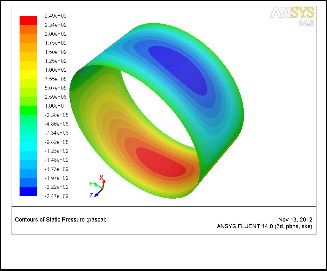
Fig.15: contours of pressure at eccentric ratio 0.3
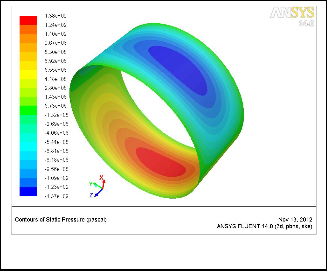
Fig.16 : contours of pressure at eccentric ratio 0.5
Fig.14: contours of pressure at eccentric ratio 0.1
Fig.17: contours of pressure at eccentric ratio 0.7
IJSER © 2013 http://www.ijser.org
International Journal of Scientific & Engineering Research Volume 4, Issue3, March-2013 6
ISSN 2229-5518
ACKNOWLEDGMENT
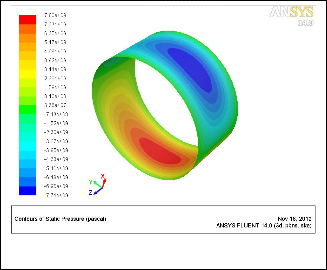
Firstly, I take this opportunity to thank Dr. Md. Yousuf Ali and Dr. Mansoor Hussain who have spared their valuable time and appended novel ideas to guide me in limelight.
I am Thankful to our beloved Sri. Shaik Kareem saheb and Dr. S. Mahboob Basha for their encouragement and coopera- tion for the successful completion of this work. I am also thankful to the Al Habeeb Charitable Trust for providing appropriate environment and grants required for the comple- tion of this work.
REFERENCES
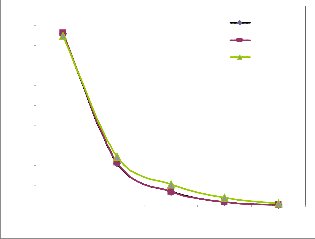
Fig.18: contours of pressure at eccentric ratio 0.9
5
[1] Cheng-I Weng, Chein-Ru Chen “Linear stability of short journal bearings with consideration of flow rheology and surface rough- ness.” Journal of Tribology international, Vol. 34, pp. 507-516, Octo- ber 2000.
[2] Michel M. Khonsari, E. Richard Booser “Applied Tribology Bearing
Design and Lubrication”.
[3] Bernard J. Hamrock, Steven R. Schmid, Bo O. Jacobson “Fundamen- tals of Fluid Film Lubrication”.
4.5
4
3.5
3
2.5
2
1.5
1
0.5
0
from CFD from ma tla b re f2
0 0.2 0.4 0.6 0.8 1
Ecce ntric ra tio
[4] Andras Z. Szeri “Fluid Film Lubrication Theory & Design”.
[5] Ram Turaga, A.S. Sekhar, B.C. Majumdar “The effect of roughness parameter of hydrodynamic journal bearing with rough surfaces” Journal of Tribology International, vol 32, pp.231-236, may 1999.
[6] J. Ramesh ,B.C Majumdar and N.S. Rao “ stability characteristics of rough submerged oil elliptical bearings under dynamic load” Journal of Tribology international, vol 30, pp. 857-863, December 1997.
[7] S.K Guha “Analysis of steady-state characteristics of misaligned hydrodynamic journal bearing with isotropic roughness effect” Jour- nal of Tribology International, vol 33, pp. 1-12, December 1999.
[8] J.Y.Jang and M.M.Khonsari “Thermoelastic instability with consider- ation of surface roughness and hydrodynamic lubrication” Journal of Tribology, Vol 122, pp. 725-732, October 2000.
[9] A.Raj and P.Sinha “Transverse roughness in short journal bearing
under dynamic loading” Journal of Tribology International, Vol 16,
Fig.19: Comparision of sommerfeld number with eccentric ratio
4 CONCLUSION
The static characteristics of the finite bearings for various L/D ratios are determined for three types of the surface roughness orientations. Longitudinal surface roughness has greater effect on the Sommerfeld number irrespective of the L/D ratio. Sommerfeld number and eccentricity are plotted for three sur- face roughness orientations at different L/D ratios. The load carrying capacity is increased by 52.57% compared with the bearing having zero surface roughness. It is the clear evidence that the surface roughness has the effect on the performance of static characteristics of the finite bearings. From the graphs it is observed that the calculated values are deviated from the actual values.
pp. 245-251, October-1983.
[10] Cheng-Husing Hsu,Jaw-Ren Lin and Hsiu-Lu Chaing “Combined effects of couple stresses and surface roughness on the lubrication of short journal bearings” Industrial Lubrication and Tribology, Vol 55, pp. 233-243, 2003.
[11] H. Hashimoto “Surface roughness effects in high-speed hydrody- namic journal bearings” Journal of Tribology, Vol 119, pp. 776-780, October-1997.
[12] J.Ramesh and B.C.Majumdar “stability of rough journal bearings using nonlinear transient method” Journal of Tribology, Vol 117, pp.
691-695, October 1995.
[13] Majumdar B C, Ghosh M K “stability of a rigid rotor supported on rough oil journal bearings” Trans ASME, Journal of Tribology, Vol.
112, pp,73-77, 1990.
[14] J. Ramesh, B.C Majumdar, and N.S Rao, “Stability characteristics of rough submerged oil elliptical bearing under dynamic load”, Tribol- ogy International, vol.30, pp.857-863, 1998.
[15] Ram Turaga, A.S Sekhar and B.C Majumdar, “The effect of rough- ness parameter on the performance of hydrodynamic journal bearing with rough surfaces”, Vol.32, pp. 231-236, 1999.
[16] K. Raghunandana, and B.C Majumdar, “Stability of journal bearing
IJSER © 2013 http://www.ijser.org
International Journal of Scientific & Engineering Research Volume 4, Issue3, March-2013 7
ISSN 2229-5518
system using non-Newtonian lubricants: a non-linear transient anal- ysis” Tribology International, vol.32, pp. 179-184, 1999.
[17] Cheng-I Weng, Chein-Ru Chen “Linear stability of short journal bearings with consideration of flow rheology and surface rough- ness.” Journal of Tribology international, Vol. 34, pp. 507-516, Octo- ber 2000.
[18] S.K Guha, “Analysis of steady state characteristics of misaligned
hydrodynamic journal bearings with isotropic surface roughness ef- fect” Tribology International, vol.33, pp.1-12, 2000.
[19] J.Y Jang and M.M. Khonsari, “Thermo elastic instability with consid- eration of surface roughness and hydrodynamic lubrication” ASME Journal of Tribology, vol.122, pp.725-732, 2000.
[20] T.V.V.L.N. Rao, S.Biswas and K.Athre, “A methodology for dynamic coefficients and non-linear response of multi lobe journal bearings” STLE Tribology Transactions, vol.40, pp. 111-117, 2001.
[21] Cheng-Hsing Hsu, Jaw-Ren Lin, and Hsiu-Lu Chaing, “Combined effects of couple stresses and surface roughness on the lubrication of short journal bearing”, Industrial Lubrication and Tribology, vol.55, pp.233-243, 2003.
[22] Bernard J Hamrock, “Lubrication fundamentals”, NASA TM 81762. [23] B C Majumdar and D.E. Brewe, “Stability of rigid rotor supported on
oil film journal bearings under dynamic load”, NASA TM 102309.
[24] M.M. Khonsari, D.E Brewe, “On the performance of finite journal
Nomenclature

Symbol Parameter
hT nominal film thickness
h distance between the mean levels of the two surfaces
1 , 2 random roughness amplitudes of the two surfaces
n power-law index of the non- Newtonian fluid
p Pressure
v constant of the power–law fluid
U circumferential velocity of the journal surface
p p pressure flow factors in the x and y
bearings lubricated with micro polar fluids”, NASA TM 100293.
[25] Sumit Singhal, “A simplified thermo hydrodynamic stability analysis of the plain cylindrical hydrodynamic journal bearings”, M.S Thesis,
xx ,yy
s xx
directions
shear flow factor in the x direction.
Louisiana state university and agricultural and mechanical college, August 2004.
[26] Bharat Bhusan, “Modern tribology hand book volume one”.
standard deviation of the composite
roughness surfaces with standard
deviations and
[27] Bernard J. Hamrock, Steven R Schmid and Bo O Jacobson, “Funda- 1 2
mentals of fluid film lubrication second edition”.
[28] Frene, D. Nicolas, B. Degueurce, D. Berthe, M. Godet, “Hydrodynam- ic lubrication”, Tribology series, 33, Elsevier.
[29] Michal M. Khonsari, E Richard Booser, “Applied Tribology bearing
design and lubrication”.
pi , j hi NS
pressure at any point i, j
film thickness at any point i, j
speed of the journal
C radial clearance
R radius of the bearing
L length of the bearing
IJSER © 2013 http://www.ijser.org
International Journal of Scientific & Engineering Research Volume 4, Issue3, March-2013 8
ISSN 2229-5518
IJSER lb) 2013
http://www.ijserorq



















